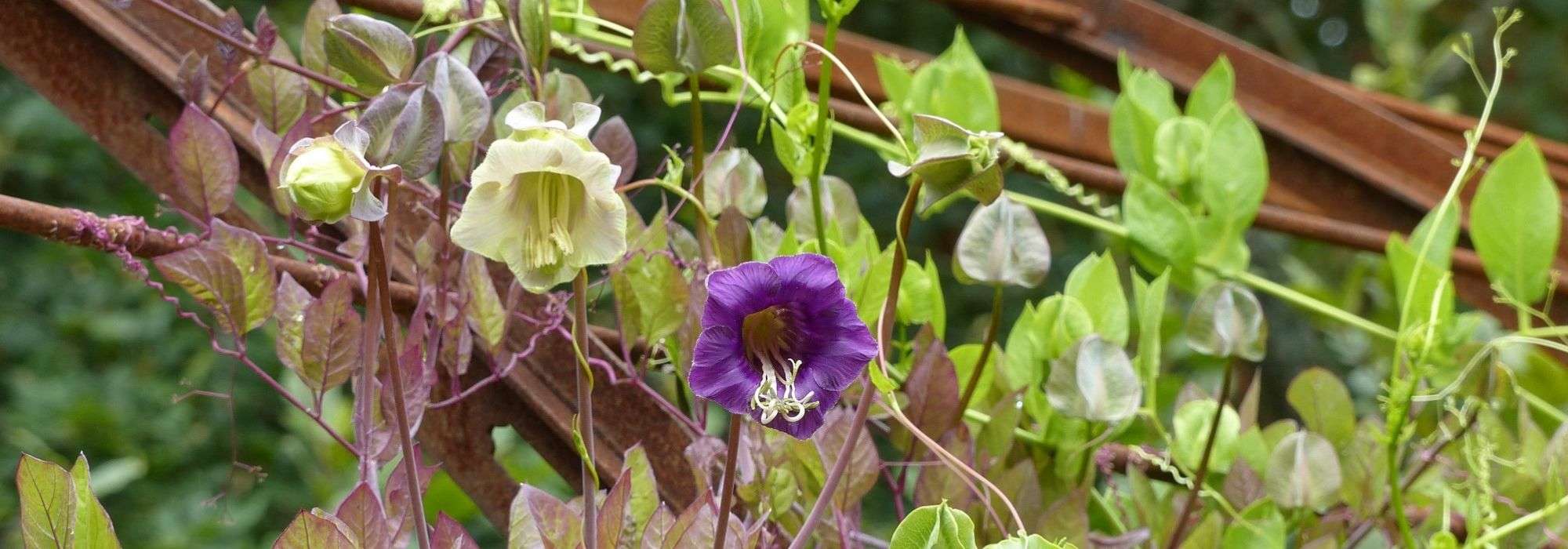
Cobaea, Cobaea scandens : sowing, planting
Contents
Cobaea in a nutshell
- Cobaea is a pretty climbing plant from Mexico, very floriferous from summer to autumn
- It produces an exceptionally original flowering made up of delicate upturned bells, at first creamy green then purple, blue or white, nestled in lush foliage
- With rapid growth, it cloaks any support provided within a few weeks
- It is a frost-tender plant, grown as an annual in our climate or in a conservatory
- Undemanding, it is easy to grow in cool soil and only vulnerable to frost
- Perfect for flowering walls, wire fences or pergolas right up to the frosts, and grows very well in pots
A word from our expert
Originating especially from Mexico, Cobaea or cobea is a pretty climbing plant, highly floriferous and notable for its flowering of large violet-blue or white bell-shaped flowers.
Its continuous flowering from summer until first frosts and rapid growth make it a top choice as a climbing plant: vigorous, stems of Cobaea scandens cling unaided to any support, ideal for dressing walls, pergolas, trellises, wire mesh fencing and fences or scrambling up a tree. Well established, it can reach 5 m in a single season!
You can also grow it in a pot.
Frost-tender, this voluble liana is most often grown as an annual in our gardens or kept potted and overwintered away from winter rigours in a greenhouse or conservatory. In regions with mild winters cobaea can remain in the open ground.
It adapts to any soil that is not too dry and really requires little care, only vulnerable to severe frosts.
Its ease of cultivation allows wide use in the garden, particularly alongside other climbing plants such as ipomoeas or sweet peas.
From germination to the sowing of cobaea seeds, discover everything you need to know about this beautiful annual climbing flower that charms with its originality and brings a nostalgic and romantic touch to the garden!
Description and botany
Botanical data
- Latin name Cobaea
- Family Polémoniacées
- Common name Cobée
- Flowering Floraison juillet à octobre
- Height 2 à 5 m
- Sun exposure Soleil
- Soil type tous bien drainés et frais
- Hardiness gélive
The Cobaea is a perennial climbing plant native to tropical and subtropical regions of the Americas and Mexico. It belongs to family Polemoniaceae, like phlox. Not hardy in our climates, this tropical liana is generally grown as an annual but proves perennial in mild climate.
Genus includes 25 perennial species but only Cobaea scandens, also called climbing cobaea, is cultivated in Europe. This type species, which produces bluish-purple flowers, has given rise to a few rare cultivars, such as ‘Alba’ with white flowering or ‘Violet Blue Bells’ with purple flowers.
With very rapid growth, climbing cobaea can reach 3 to 5 m in height, sometimes more, and about 1 to 2 m in width in a single season. Like peas, it clings to any support you provide using long tendrils. It is therefore ideal for covering a wall, a trellis, an arbour, wire mesh or a fence.
Exuberant, the deciduous foliage brings a certain lushness to the plant. Carried on numerous fine voluble stems, it is formed of 3 pairs of leaflets ovate to elliptical, about 2 to 10 cm long. Leaf surfaces show marked veins. The terminal leaflet ends in a fine forked tendril allowing the plant to cling. Slightly downy, leaves are dark green.
Cobaea’s flowering is one of most distinctive of the warm season. Nestled in the axils of leaves within this dense, opulent foliage, pretty campanulate flowers open from July until first frosts. This bushy growth, which can hide part of the display, is adorned with a profusion of bell-shaped inflorescences set in a large greenish calyx 3 to 5 cm in diameter.
They open as corollas broadly expanded measuring 5 to 6 cm in diameter and 7 to 8 cm long, whose fused petals show upturned lips: their astonishing shape, evoking cathedral bells, has earned cobaea the nickname in Britain “cathedral bells”. A cluster of long white or yellow stamens projects from their wide throat, sometimes more lightly veined in purple varieties.
Cobaea flowers also have the particularity of displaying evolving colours as they open; they are born a yellow-green shade, gradually turning translucent white then purple-violet at maturity in Cobaea scandens ‘Violet Blue Bells’, and white gradually tinging to ivory in Cobaea scandens ‘Alba’.
They give off a light fragrance, more or less pleasant, which intensifies at nightfall.
Only in mild climate do the flowers give way to large olive-shaped purple fruits containing the seeds.
Frost-tender, Cobaea is a tropical liana that does not withstand sub-zero temperatures and will therefore be grown as an annual in most regions. It thrives in sun, tolerating partial shade in southern France, well sheltered from winds. It will be satisfied with ordinary soil provided it is well drained, humus-bearing and remains cool.
The Cobaea is the ideal climbing plant to quickly cover a wall, an unsightly fence in a sunny position, a tree trunk or simply to dress an arbour, to trail down a pergola or trellis.
It also thrives in a pot to flower terraces and balconies or in a conservatory or patio.
Main species and varieties
Only Cobaea scandens is in cultivation. It declinates into some cultivars with purple, blue-violet, white, more rarely pink flowers.
Our favourites
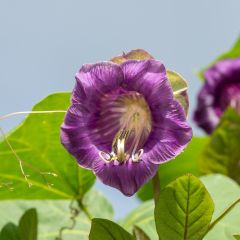
Cobea scandens Violet Blue Bells Seeds
- Flowering time August to November
- Height at maturity 3 m
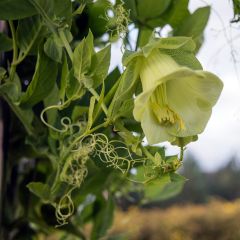
Cobaea scandens Climbing White Seeds
- Flowering time August to November
- Height at maturity 4,50 m
Discover other Cobaea seeds
View all →Available in 1 sizes
Available in 1 sizes
Sow Cobaea seeds
When to sow Cobaea?
Cobaea seeds are sown from March to April, in a warm place at 18-24°C in buckets or in a tray. In mild climates, sowing can be done directly in the ground in May.
How to sow?
To sow your Cobaea seeds:
- Start by soaking your seeds in a glass of water for 2 hours,
- Prepare a tray filled with a good sowing compost mixed with sand
- Sow seeds on surface
- Cover them very lightly with compost
- Keep shelter temperature at a minimum of 15°C
- Keep substrate moist but not waterlogged and at least 20°C during germination (between 10 and 21 days)
- Three weeks later, transplant seedlings into individual buckets
- Keep substrate moist until planting
In mild climates, you can also sow directly in warmed soil in April-May. Stake as soon as seedlings have become sturdy.
Planting cobaeas
Where to plant Cobaea in the garden?
From its tropical origins, the Cobaea has retained a great sensitivity to cold, withering at the first frosts. That is why this herbaceous liana is usually grown in our country as an annual in open ground or in a pot as an indoor plant because of its low hardiness. It is also an excellent veranda plant. In cool climates, if you want to keep it: bring it in for winter under a greenhouse or indoors!
To flower well, it will appreciate a sunny, warm position or a shaded one in southern regions, sheltered from winds and cold draughts.
This lovely annual climber, undemanding about soil type, will grow quickly in a light, relatively humus-bearing, free-draining soil that stays cool in summer. Soil that is too rich would favour foliage at the expense of flowering.
Provide an appropriate support and enough space: it will dress, in a single season and until first frosts, a south-facing old stone wall, a wire mesh, an arbour, the trunk of a tree, a trellis or a pergola and can also tumble down over a low wall.
Grown in a pot, it flowers on sunny terraces and balconies and can also find a place in the veranda where it will thrive in warmth all year round.
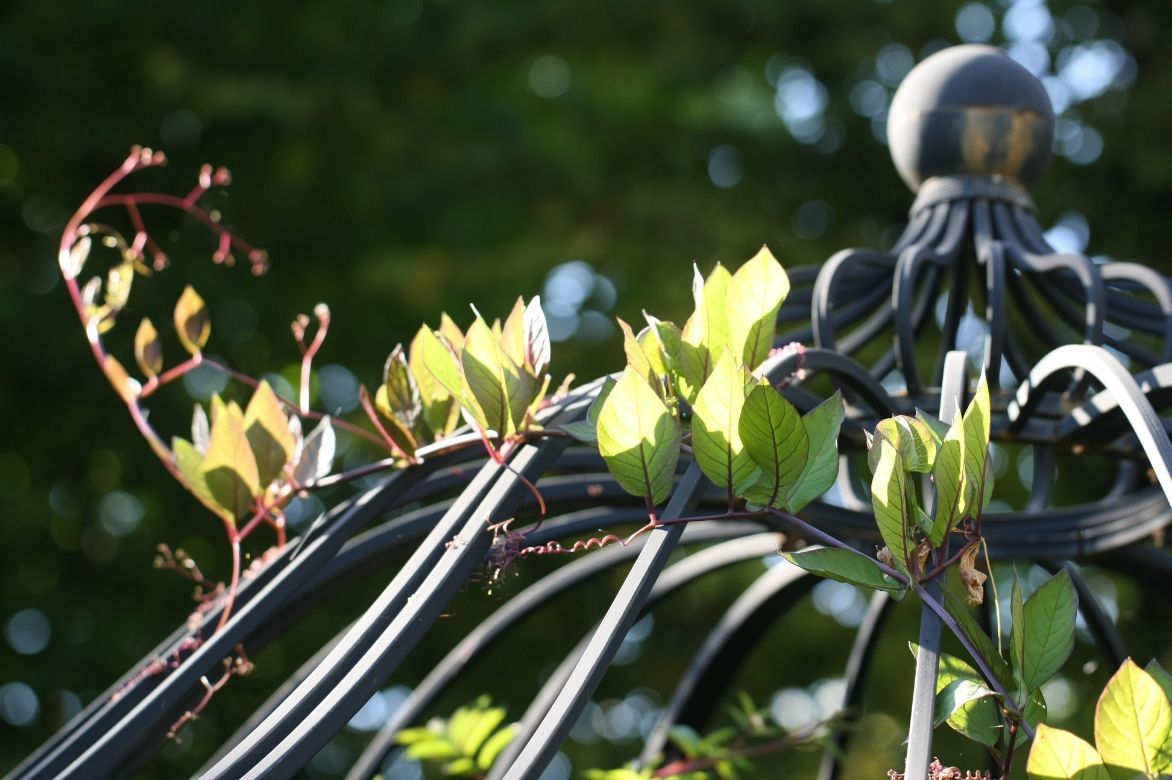
Cobaea elegantly dresses an arbour!
How to plant, in open ground or in a pot:
- In open ground
As soon as risk of frosts is finally past, from mid-May to mid-June, you can plant your young Cobaea plants in open ground outdoors, spacing plants about 80 cm to 1 m apart. Provide a support straight away for them to climb.
Steps to ensure successful planting of Cobaea plants:
- Dig over soil to half spade depth
- Dig a hole three times wider than the rootball
- Make a good bed of gravel at the bottom of the hole
- Place the rootball, without burying the collar too deeply
- Install a small stake to guide shoots towards the support
- Backfill with garden soil mixed with potting compost and coarse sand
- Firm down
- Mulch the base to keep soil cool
- Water regularly but moderately to keep soil cool
- In a pot
The Cobaea is well suited to growing in a large pot of at least 40 cm diameter. Brought outside in fine weather, it should be put away before frosts and kept in a veranda or a cool greenhouse throughout the year.
- Plant in a rich, well-draining mix of two thirds potting compost and one third garden soil; you can also add some sand
- Water regularly but not excessively, allowing soil to dry between waterings
- Feed 3 to 4 times during the season with a liquid organic fertiliser
- In autumn, bring pots indoors to protect from frosts
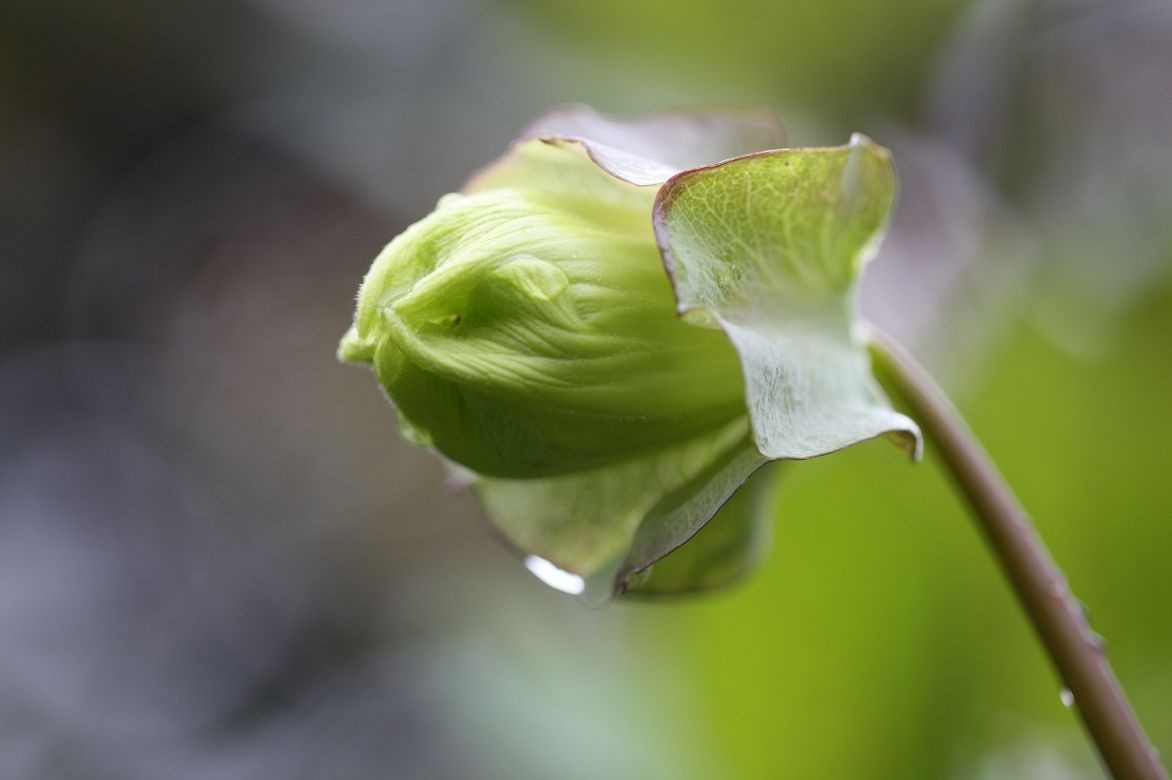
The campanulate flowers of Cobaea scandens are first a pretty pale green before turning violet
Care and maintenance
Very undemanding, Cobaea requires little attention. It is a climbing plant easy to grow provided it is not short of water.
In summer, keep soil cool, especially during hot spells: water regularly, always at the base of the plant, at least once a week, taking care not to waterlog the soil as it dislikes excess water.
With a good mulch, it will tolerate a short drought fairly well, provided it is watered regularly.
Cobaea needs support to grow, as its stems are not rigid enough to bear its weight. At the start, help its stems climb: consider staking and providing a support to your Cobaea as soon as planted in ground or in a pot. After that, it will manage by itself.
Cobaea in a pot needs feeding with fertiliser for flowering plants (every two weeks) and more regular watering throughout the growing season.
Remove faded flowers to encourage new flowering.
If foliage becomes exuberant and hides the flowers, use pruning shear to remove a few leaves.
In autumn, in cold regions, lift your Cobaea from ground and bring pots indoors to shelter from severe frosts into a place where temperature will not fall below 15°C. Then reduce watering to the strict minimum.
In mild climate, this climbing plant can overwinter in ground: cut the clump back to ground level and cover the base with a tile and a good layer of dry leaves. In spring, when it resumes growth, feed it with mature compost.
In the garden, no parasitic pests or diseases are known; ultimately, Cobaea fears only frost. However, Cobaea grown indoors can be more sensitive: if necessary, sprays of soapy water will dislodge aphids and nettle macerations will eliminate red spider mites.
Propagation
If cobaea is propagated by sowing in spring (read our section “When and how to sow cobaea seeds”), it is also possible to propagate it by cutting in June.
To do so :
- Take woody cuttings 10 to 15 cm long, just below an eye
- Remove leaves from base of stem and remove flowers
- Insert cuttings into buckets filled with a light, well-draining mix of turf and river sand
- Keep cuttings moist by misting regularly with a sprayer, without soaking them. Overwinter them frost-free, under a warm frame (18°–25°C) during winter
- Plant in ground or pot following spring, in May when they have sufficient roots and soil has warmed
Companion planting with cup-and-saucer vines in the garden
With its slightly vintage charm, Cobaea will clothe any support made available to it within weeks and, while this climbing plant does well alone, it will accompany a great number of other climbing annuals or not, such as summer-flowering perennials. It finds an easy place in romantic gardens, where it asserts itself in soft white or violet harmonies.
Plant perennials at its base, such as asters, hardy geraniums and chrysanthemums to keep roots cool and support its flowering right up to winter.
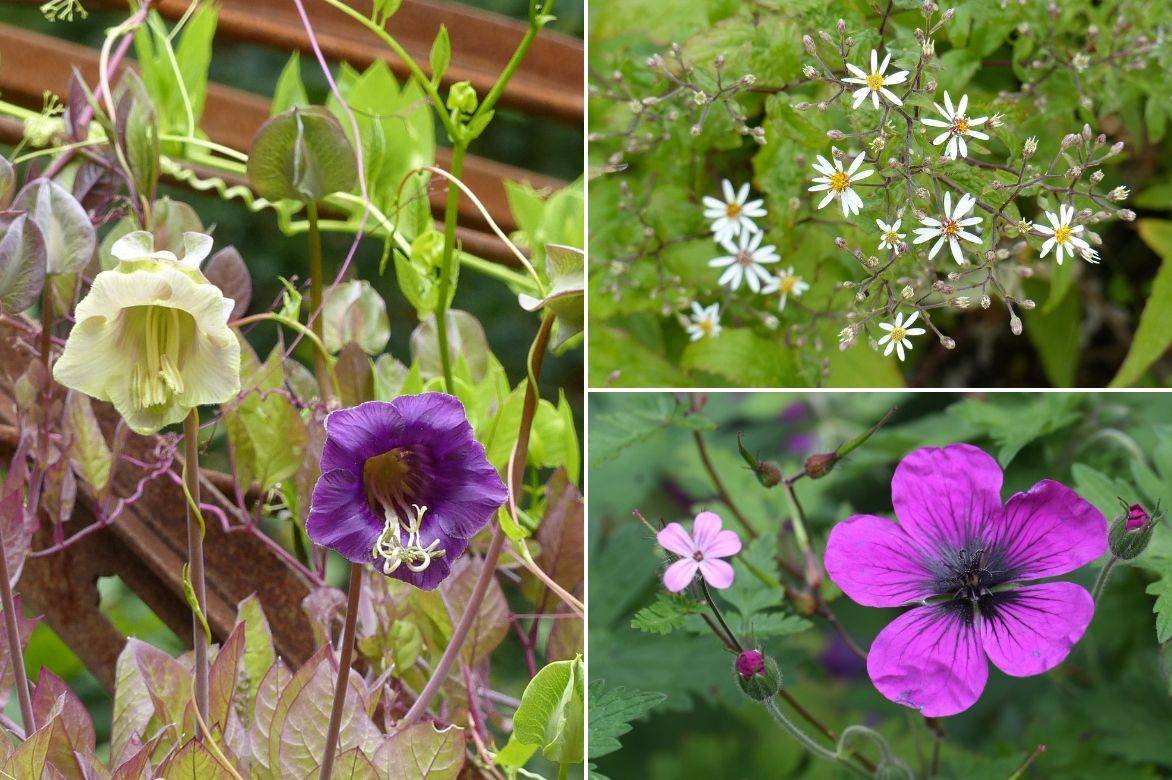
An idea for a combination: Cobea scandens, Aster divaricatus and Geranium ‘Dragon Heart’
On a wire fence, trellis or arbour, its original flowering will echo other unusual climbing plants such as Canary nasturtium, tuberous wisteria, trumpet vine or Campsis, known as “Jericho’s trumpet”, or Rhodochiton atrosanguineus.
For more classic pairings, mix it with morning glories, sweet peas and clematis.
Also let it climb over a rose, a wisteria or a conifer, around which it will wind itself elegantly.
In a more contrasted scene, a Cobaea scandens ‘Violet Blue Bells’ will form a striking combination with the warm-toned flowers of nasturtiums or a black-eyed Susan.
Useful resources
- Just bought Cobaea seeds? Discover on our blog how to plant and care for these beautiful annuals.
- With rapid growth allowing good development over a single summer, don’t miss our annual climbers!
- Looking for unusual climbers to dress your walls and pergolas? You’ll find them in our nursery!
Frequently asked questions
-
Is it possible to harvest seeds from my cobaea?
Cobaea only sets fruit in a warm climate, so it is quite rare to see this happen in our gardens. However, cobaeas grown in pots and kept warm indoors can have their flowers turn into purple fruits containing the seeds you can harvest for sowing.
- Subscribe!
- Contents
. Happy gardening!](https://www.promessedefleurs.ie/blogwp/wp-content/uploads/2019/05/cobée-tout-savoir.jpg)































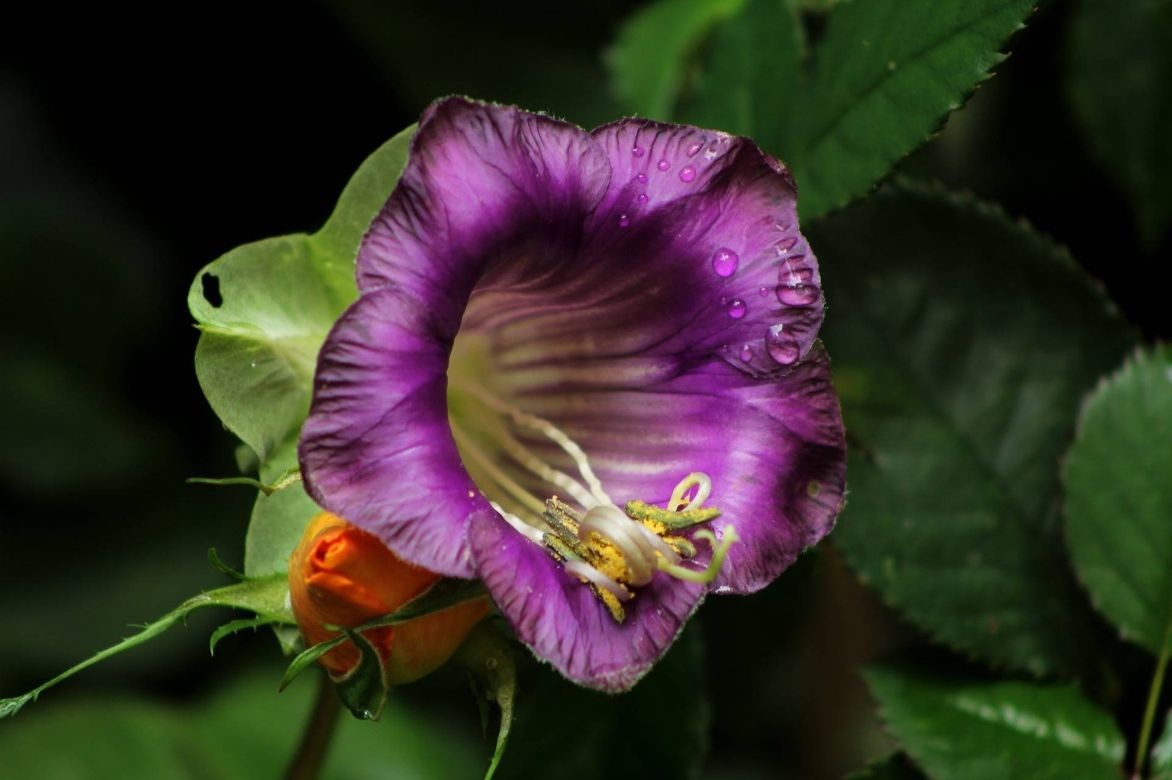


Comments